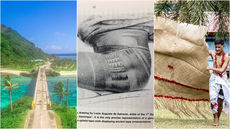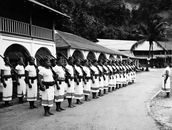TALES OF TIME - PIC CHURCH GOWN OF CHOIR MISTRESS EPI PHETHEAN
By Aaron Taouma
Objects inspire a sense of connection between time and space. Museum’s bring together and present such objects reminding us who we are and were as a collective over time. A jacket may represent an entire political movement (such as the Polynesian Panthers) and a Bill Sevesi steel guitar and aloha shirt may simultaneously represent the life of a musical legend and the hopes and dreams of a generation - sung and played out in music.


Auckland Museum’s new permanent gallery - ‘Tāmaki Herenga Waka: Stories of Auckland’ – presents “our stories” through such significant objects.
Here, you’ll find the items mentioned above as well as a crimson church gown worn by the late P.I.C. Youth Choir Mistress Mrs. Epi Phethean (nee Enari). The gown is dated 1966 (Tina Wichman) and is a material representation of what is one of the most significant connectors of Pacific stories in Aotearoa.

The P.I.C. (Pacific Island Church or P.I.C.C. - Pacific Island Congregational Church), was established in 1948 in Ponsonby and led by Reverend Robert Challis, Reverend Tariu Teaia and Reverend Leuatea Sio.
It became not only the first port of call for many new island immigrants to the country but also the spiritual centre of a combined Pacific village – bringing together Sāmoan, Cook Island (Kuki Airani), Niuean and Tongan congregations under one roof.
In 1962 it was established at 2 Edinburgh St; Newton, off Karangahape Rd; and in 1970 the church merged with the Presbyterian Church Aotearoa NZ and became known as the P.I.P.C. (Pacific Island Presbyterian Church).
It is not only the first Pacific church of Aotearoa but also home to many families.

Reverend Sio in his time leading the church (over some 60 years) became known as ‘the father of Pacific Island communities in Aoteraoa’ and in a Facebook remark his daughter Rosalina Sio says;
"P.I.C. Newton will always be our home base no matter where we are or will be during this lifetime. Out of Newton we have so many leaders of different churches, community groups, even MPs...So proud of being raised at Newton by our parents.”
The gown represents the significance of this Pacific People’s home over the years but also is of a particular time in our histories when the church was still young and full of the energy of newly arrived families and an emerging first generation of New Zealand born Pacific Islanders.
This new generation were pioneers of their time. Many had been part of the choir led by Mrs. Epi Phethean; such as the iconic singing trio ‘The Yandall Sisters’ and operatic star Iosefa Enari (Epi’s nephew).

Dr Melani Anae is a Polynesian Panther and Senior Lecturer, Director of Research, Pacific Studies at the University of Auckland. She was the pianist in Mrs. Phethean’s choir and relates;
“The choir was a kind of passive tutor helping us Sunday by Sunday to improve our understanding of gagana Samoa and at the same time extend our repertoire of Samoan language hymns...regaled in their splendid gowns [they] were a sight to behold and their natural harmonies learned from a life time growing up with lotu added a dimension of beauty and richness to Sunday worship services.”
She continues, “[We had] a dress code; girls in white dresses and boys in white shirts, black tie and black trousers...My personal memory of Epi was that she was very elegant and always impeccably dressed. Although she had a quiet voice she was very strict...When she raised her baton and looked over to me to commence playing I simply had to swallow my nervousness and play…”

Adele Paris is one of the Yandall Sisters. She recollects,
“Aunty Epi (as we knew her) was a huge role model for all us young choir members of PICC. She had a great ear for music and taught us in the sol-fa style which we haven't seen anyone do since! So very musical, she could immediately tell when some-one was flat, sharp or just plain out of tune,” she laughs and continues.
“She even had cous’ Laloifi Lelaulu (Repeka Lelaulu) & I stay at her place for a couple of weeks so we could peacefully study for S. Cert. Exams. Coming from rather large noisy families it was a blessing...Loved that lady and PICC are indebted to her for all that she did for us. R.I.L. Aunty Epi.”

Sefa Enari is the great-nephew of Mrs. Phethean and shares his name (Iosefa) with his operatic pioneering uncle Iosefa Enari (both named after the original Iosefa a generation before). Sefa originally organised for the display of this gown in an exhibition presented as part of the P.I.C.’s 70th anniversary. He elucidates;
“They always wore their graces with well attired aires and pinnacled crosses of faith. The crimson and the cross, was for me, the style of a period of time very much associated with Grandma Epi. Later it was purple and yellow.”
Sefa and his family call her Grandma, though she was a Great Aunt. He relates that the address listed on his birth certificate was at her house in Williamson Ave, Grey Lynn and she had passed away when he was still quite young. His mother, Seira Aiono nee Enari, was Epi’s niece and through her also became a Sunday school teacher at the P.I.P.C.

He continues,
“My mother held this gown and others in a back room wardrobe and we especially brought it out for the anniversary. We’re very honoured to now have this represent our church and family, which for me evokes remembrances not only of the choir, which was very influential in my music and dance life but also of all our church’s contributions to the Tāmaki and Aotearoa community.”


It seems Mrs. Phethean’s influence went beyond just her life at P.I.C.. She is mentioned in Albert Wendt’s memoirs of his early life - ‘Out of the Vaipe: The Deadwater, a Writers Early Life’. Miss. Epi Enari, as she was known then, had been a primary school teacher in Samoa and taught a generation of scholarship students - the brightest and best of the country sent out to the world to be educated in Western ways and return to lead the country.
We also find that she was a passenger on the famous ship which many of our early migrants had made their way to Aotearoa – the Matua, 1945.
Sefa concludes, “The same ethos taken by Samoa was taken by our church but this time it was that of going from our Pacific communities out into the Pakeha and Māori world of Aotearoa and the globe beyond.”

Today, the children of the P.I.C. can be found across the motu and around the world. But, their first home, their church and the journeys of their families can be connected to in the presentation of a church gown sitting in a glass case in a Museum on a hill over-looking Tāmaki Makaurau.
.
* Tāmaki Herenga Waka: Stories of Auckland is a permanent exhibition suite at the Auckland Museum. Find out more at: https://www.aucklandmuseum. com/visit/galleries/tamaki- herenga-waka
* You can read more about the P.I.C. 70th anniversary exhibition here - https://www.thecoconet.tv/ coco-talanoa/blog/pic-museum- celebrating-70-years/
.




